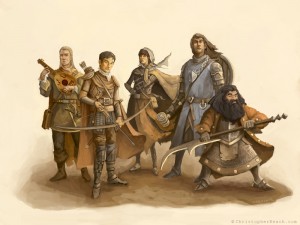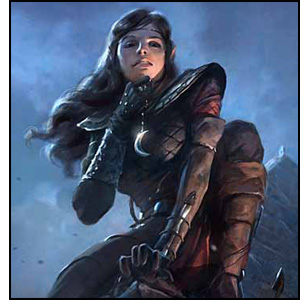
 I was recently reminded of the challenges involved in helping a player craft a character who doesn’t necessarily fit very well into a functional group. In my experience, most players like having a specific niche for their character, which naturally begs the consideration that the niche will be valuable to the party. A character who is a brilliant tactician, for example, is useless if he is a condescending prick who tries to dictate actions without soliciting feedback. His strategies will never be realized, and the player will just get frustrated. That isn’t saying that you can’t play the same condescending prick and get your ideas into play… you just have to have a party that wants to listen.
I was recently reminded of the challenges involved in helping a player craft a character who doesn’t necessarily fit very well into a functional group. In my experience, most players like having a specific niche for their character, which naturally begs the consideration that the niche will be valuable to the party. A character who is a brilliant tactician, for example, is useless if he is a condescending prick who tries to dictate actions without soliciting feedback. His strategies will never be realized, and the player will just get frustrated. That isn’t saying that you can’t play the same condescending prick and get your ideas into play… you just have to have a party that wants to listen.
“Lone wolf” characters are the bane of GMs the world over… particularly in large groups. The character who doesn’t engage in a manner that engenders return consideration from his or her pack may as well be playing a different game, and feeding the wolf is a grave disservice to everyone involved: the GM who can’t fulfill the needs of the party and the PC, the player whose PC doesn’t get the attention he needs, and the group who has to roll their eyes and deal with it. But let me expand the metaphor from “lone wolf” to the much less evocative “square peg.”
“Square pegs” are PCs who just don’t function well within the group dynamic. Without careful consideration, the roster of square peg characters can include: the Leroy Jenkins of the group, who doesn’t pay attention and does his own thing; the Madman, who acts in nonsensical ways that seem humerous to the player but often cause the party no end of grief; the Lone Gunman, who isn’t interested in being part of the group at all; the Turncoat, who is more than ready to sell everyone up the river for a decent bribe; the Notepasser, who may or may not be devoted to the party’s plans but behaves so secretively that no one can ever trust him; and even the Idealist, who has no interest in the party’s goals and constantly insists on adherence to strict behavioral policies. There are plenty of other archtypes, but I think you get the idea.
So dearest Dragon, you say… how do I play my asshat tactician and still get the party to work with me…? Well, I’m glad you asked.
 The most frustrating thing about players who insist on building a square peg character is that they the motive often extends from the player’s psychological need for attention or control, which frequently means candlelit midnight rendezvous arranged by carrier pigeon and encrypted with an ancient cypher to get together with the GM to discuss the details during character creation. (What, too dramatic? You don’t know my players…) This, rather obviously, only exacerbates the problem… If your player wants to hide his or her entire character concept and background from the rest of the table, this should set off a series of claxons in the GMs head that are often accompanied by Klingon battle music.
The most frustrating thing about players who insist on building a square peg character is that they the motive often extends from the player’s psychological need for attention or control, which frequently means candlelit midnight rendezvous arranged by carrier pigeon and encrypted with an ancient cypher to get together with the GM to discuss the details during character creation. (What, too dramatic? You don’t know my players…) This, rather obviously, only exacerbates the problem… If your player wants to hide his or her entire character concept and background from the rest of the table, this should set off a series of claxons in the GMs head that are often accompanied by Klingon battle music.
The secret to making your square peg character a success is working with the other players rather than against them. A little counter-intuitive, isn’t it? Let’s review a couple of inherent rules of successful RPGs. First… don’t split the party. This is often treated as a literal bit of dogma… and to be fair, I tend to like splitting up the party (more on that in another blog). But it’s also a great metaphor. For the same reason that juggling separate groups of PCs can bog down the game, trying to accomodate square peg characters can be disruptive and unfun. Which leads to the second axiom: Your job as a player is to enable and enhance the enjoyment of the game for everyone involved. That’s right. Your job. You may not feel like you have much influence over whether Mopey Susan or Irritable Oscar are having any fun, but you certainly have the power to make it less fun. And playing a character that takes something away from the challenges and victories enjoyed by the group is a great (read as “dickheaded”) way to do that.
If you want to craft a square peg character and make it fun for everyone, involve them in the situation. If the insane wizard in the party is just some shmuck who keeps creating havoc to destroy the party’s well-laid plans, then that wizard’s eventually gonna get left behind or meet with an unfortunate “accident.” If he’s my brother, however, or my employer… or if he’s the maguffin, as in “his addled brain holds the secret that the bad guy desperately wants and we aren’t letting him out of our sight”… well, that changes things. Wanna play the lone wolf? Make him a usurped prince and ask the other players if they would be willing to be servants of his dead father, who asked them to help keep him safe. Or make him a lone wolf who has sworn to protect another member of the party. Give your square peg a powerful tie to the group or a reason to be part of their plans.
 In my online zombie apocalypse campaign, one of the PCs is a heartless prize-fighter who is as likely to trip his companions and leave them to the monsters as he is to give them a hand. The player initially tempered this propensity by establishing him as a prisoner of a US marshall, played by one of the other players, wrongfully accused of murdering his wife. The prisoner transport was disrupted by the zombie apocalypse, of course, and the marshall is no longer around… which has made it a little more challenging for the player to keep control of his own character, but he finds ways to work with the party as much as he reasonably can. After all… there’s safety in numbers.
In my online zombie apocalypse campaign, one of the PCs is a heartless prize-fighter who is as likely to trip his companions and leave them to the monsters as he is to give them a hand. The player initially tempered this propensity by establishing him as a prisoner of a US marshall, played by one of the other players, wrongfully accused of murdering his wife. The prisoner transport was disrupted by the zombie apocalypse, of course, and the marshall is no longer around… which has made it a little more challenging for the player to keep control of his own character, but he finds ways to work with the party as much as he reasonably can. After all… there’s safety in numbers.
So… do you have a square peg character idea? Want some help figuring out how to make it work with the group? Bring it on.
Orryn Emrys, the Prismatic Dragon, is the director of the Prismatic Tsunami web community and the host of the popular Metagamers Anonymous RPG podcast. Learn more at http://www.prismatictsunami.com.
Sorry, the comment form is closed at this time.